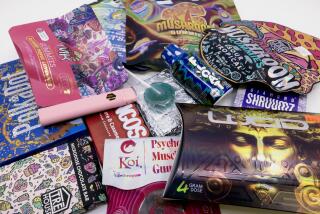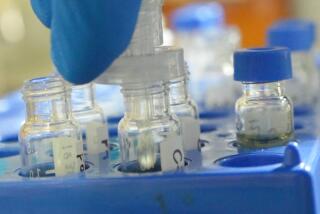On the frontier of medical pot to treat boy’s epilepsy
MODESTO —Topamax. Depakote. Phenobarbital. The list goes on. Before Jayden David turned 5, he had tried a dozen powerful medications to tame a rare form of epilepsy. The side effects were devastating.
There were grand mal seizures that lasted more than an hour. Hundreds of times a day, muscle twitches contorted his impish face.
“If he wasn’t sleeping, he was seizing,” said Jayden’s father, Jason David.
PHOTOS: Treating son’s epilepsy
Feeling helpless, David said, he contemplated suicide. He prayed. Then one day he heard about a teenager who was expelled from school for using marijuana to help control seizures.
So began the pair’s journey into California’s medical cannabis culture.
In the 14 months since, the little boy has been swallowing droppers full of a solution made mostly of cannabidiol, or CBD, the second most prominent of marijuana’s 100 or so cannabinoids. Unlike the dominant THC, cannabidiol is not psychoactive, so the sweet-tasting infusion Jayden takes four times a day doesn’t make him high.
Down from 22 prescription pills per day to four, he now eats solid food, responds to his father’s incessant requests for kisses and dances in his Modesto living room to the “Yo Gabba Gabba!” theme song. The frequency and intensity of his seizures have been greatly reduced.
But this summer, federal prosecutors moved to close Oakland’s Harborside Health Center — the nation’s largest dispensary and the place David has relied on most for help.
The public debate over medical marijuana — which violates federal law but is legal in California, 17 other states and the District of Columbia — for the most part has pitted those who praise its health benefits against those who say it is merely an excuse to get high. Lost in the discussion has been the fact that marijuana has myriad components that affect the body in a number of ways.
CBD, for instance, was virtually bred out of U.S. plants decades ago by growers whose customers preferred the mind-altering properties of high-THC varietals. Yet it is experiencing a resurgence, having shown promise as an anti-inflammatory, anticonvulsant, neuroprotectant and cancer-fighting agent.
“Nobody is going to a dispensary for this to get high,” said Martin Lee, a Bay Area writer who has reported on cannabidiol for years. “With CBD, it’s clear that it’s just about medicine.”
::
A photo in the kitchen shows a beaming David nuzzled up against his newborn son. But the family’s joy soon clouded. Jayden had his first grand mal at 4 1/2 months. The muscle jerks followed, as did seizures that cause sudden collapse.
At 1 1/2, the blue-eyed boy was diagnosed with Dravet syndrome, a form of infant epilepsy described in medical literature as catastrophic — and potentially fatal.
David and Jayden’s mother, whose marriage failed under the stress, consulted top experts, resulting in “more drugs and more ambulance trips,” David said.
By late 2010, Jayden had tried 11 medications. The 12th was stiripentol, hailed as a potential Dravet breakthrough. But after six months, Jayden’s seizures and side effects were worse. David said his son rarely responded to those around him, had difficulty chewing and often screamed in fear.
“I was going crazy,” David said. The onetime jewelry store manager recalled stepping out onto his front lawn in April 2011 to make a phone call: “Mom,” he said. “I’m going to shoot myself in the head. I can’t stand seeing him this way.”
That Sunday, David, a devout Assyrian Christian, and his girlfriend brought Jayden to their parish. “We were asking God for signs,” David said.
The TV news story David saw the next day about the epileptic teenager seemed to offer one. Scouring the Internet, he came across decades of research documenting the therapeutic effects of CBD.
It has been shown to relieve, among other things, spasms from multiple sclerosis, anxiety and symptoms of schizophrenia. Animal studies related to the treatment of rheumatoid arthritis, Alzheimer’s, and cancer have proved encouraging.
In an application for a patent awarded in 2003, the U.S. Department of Health and Human Services deemed non-psychoactive cannabinoids “particularly advantageous to use” as antioxidants and neuroprotectants because they can be administered in high doses without risk of toxicity.
As for epilepsy, tales of cannabis use date to ancient Chinese and Ayurvedic traditions.
Studies have shown THC is “overwhelmingly anticonvulsant” in animals, said Dr. Ben Whalley, a researcher at Britain’s University of Reading, but CBD and some other non-psychoactive cannabinoids have shown similar effects without the mind-altering downside.
In a human trial during the 1970s, researchers found that four of the eight subjects who received large doses of CBD remained almost free of epileptic seizures, while three others improved. More recently, Whalley and his colleagues published results of an animal study that strongly supported CBD “as a therapeutic candidate for a diverse range of human epilepsies.”
The long-term effect on children is unknown, but studies show CBD is well tolerated by adults and animals, Whalley said. As for side effects, he said, “I would be very surprised to find it to be any worse than either Depakote or clobazam” — the anticonvulsants Jayden still takes.
When David consulted his doctor about the possibility of treating Jayden with medical marijuana, he was told: “If I were you, I would try anything.”
::
Soon after Steve DeAngelo co-founded Harborside in 2004, he went in search of a lab to test his marijuana’s potency, as well as screen it for pesticides, mold or other impurities. None would. So he invested in what would become Steep Hill Cannabis Analysis Laboratory.
While obtaining CBD wasn’t the original mission, it became a Holy Grail.
The British company GW Pharmaceuticals was marketing a drug for multiple sclerosis patients outside the U.S. that contained equal parts of THC and CBD, and was exploring further uses for the compound. Clearly, in addition to the medical benefits, there was money to be made in CBD — for growers, the dispensaries that sell sought-after strains and the independent testing labs.
Lee, who has tracked the research, said efforts to breed it back to prominence have produced about two dozen CBD-rich strains in California.
But those sold over Harborside’s retail counters still contained too much THC for Jayden. Andrew DeAngelo, Steve’s brother and a patient liaison, helped direct David to a nonpsychoactive, CBD-infused solution that the dispensary had in stock.
Jayden got his first dose June 4, 2011. Days turned into months that were largely seizure-free, David said. But the second batch didn’t work. Testing showed the CBD content was too low.
David took to the Internet again and found Al Coles, a former investment advisor turned cannabis consultant who works out of his Stinson Beach home. Coles had initially experimented with remedies for his own depression, then took up the cause for others.
Since meeting Jayden, he has spent thousands of dollars of his own money formulating and testing various concoctions. His method involves using ethanol to extract the CBD from high-content leaves or flowers, then evaporating it and reinfusing the substance with glycerin and creamed honey. The optimal ratio of THC to CBD for Jayden, his father said, appears to be about 1 to 19.
For legal reasons, Coles can’t provide the mixture directly to Jayden, so he takes it to Steep Hill to ensure the CBD content is high enough before handing it over to Harborside to be dispensed.
Coles and Harborside — which oversees customized treatments for about three dozen severely ill patients — are not charging for their services, citing the severity of Jayden’s condition and his father’s precarious finances. But locating the scarce raw material has fallen largely to David, who has visited as many as 50 dispensaries around the state. Most, he learned, don’t even know what high-CBD strains are.
He has paid $310 to $450 for an ounce of marijuana, which can make up to a month’s worth of solution. David, who focuses on his son and is no longer working, depends on donations from friends and his parish in nearby Ceres.
::
Since launching a crackdown last fall, federal prosecutors have closed hundreds of California dispensaries. Calling Harborside a “superstore” for its 108,000 members, they targeted the building’s landlords with civil forfeiture actions — a move the dispensary is fighting.
But medical marijuana advocates hold out hope for a favorable ruling from the U.S. Court of Appeals for the D.C. Circuit, which will hear oral arguments next month in a lawsuit challenging the classification of marijuana as a Schedule I substance — a dangerous drug with no medicinal value.
Although David and his son have become celebrities of sorts in the cannabis movement and among families of Dravet sufferers, who follow their journey on Facebook, some in the medical establishment balk at their choices.
“The drugs that come to market have been well screened for safety,” said Dr. Donald Olson, who directs the pediatric epilepsy program at Lucile Packard Children’s Hospital at Stanford University. “With alternative medicines like this, you are on very shaky ground. If the patient gets better, God bless them. I’m happy for them. But it’s not something I can ethically recommend.”
As for Jayden, he is now 6 years old and, in many ways, flourishing.
Speech therapy sessions provided by the school district have tripled in length due to his progress and he is being mainstreamed this fall for an hour a day. While on his heavy prescription cocktail, Jayden stumbled frequently and was unable to enter the church sanctuary but now takes Communion and sits for long periods cradled under his father’s arm. He hugs everyone who asks.
“The difference is from Earth to heaven,” said Serkes Rasho, a St. George parish security guard whom a boisterous Jayden greeted with an embrace. “Before, he couldn’t walk. He didn’t have eye contact. Now he smiles. He recognizes everyone.”
More to Read
Sign up for Essential California
The most important California stories and recommendations in your inbox every morning.
You may occasionally receive promotional content from the Los Angeles Times.










